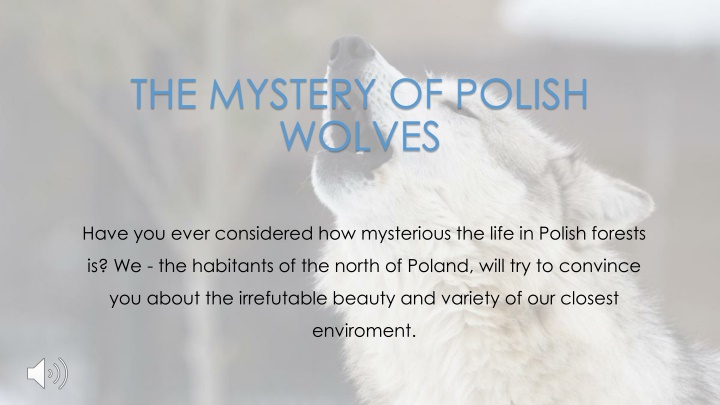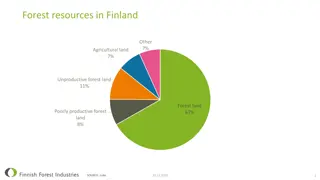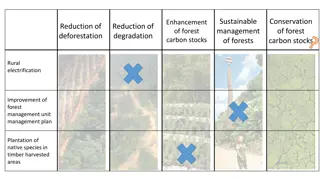Discover the Enigmatic Polish Wolves and Their Forest Habitat
Polish forests, spanning over 9 million hectares, are home to a thriving wolf population of around 1200. Witness the expansion of these majestic creatures in Poland, with a history marked by conservation efforts and challenges. Explore where these wolves live and how they contribute to the diverse ecosystem of the region.
Download Presentation

Please find below an Image/Link to download the presentation.
The content on the website is provided AS IS for your information and personal use only. It may not be sold, licensed, or shared on other websites without obtaining consent from the author.If you encounter any issues during the download, it is possible that the publisher has removed the file from their server.
You are allowed to download the files provided on this website for personal or commercial use, subject to the condition that they are used lawfully. All files are the property of their respective owners.
The content on the website is provided AS IS for your information and personal use only. It may not be sold, licensed, or shared on other websites without obtaining consent from the author.
E N D
Presentation Transcript
THE MYSTERY OF POLISH WOLVES Have you ever considered how mysterious the life in Polish forests is? We - the habitants of the north of Poland, will try to convince you about the irrefutable beauty and variety of our closest enviroment.
Forests in Poland In Poland forests cover about 9,1 mln ha, this is about 29% of our country and they are dominated by scots pine. Only 7,6 mln ha of forests is managed by the State Forests National Forest Holding. One of the most important sector of the polish economy is forestry sector. Interesting fact is that it offers direct employment to 300 000 in the forest and wood industry. (Polish wood industry is one of the biggest in the whole world). We have 23 national parks. The total area of them in 316 748, 45 ha. It is only 1% of the country area.
At the beginning The wolf has been protected throughout Poland since 1998. Now, according to official data, there are about 1200 wolves in whole Poland and the number is increasing.
Expansion of Expansion of wolves wolves Between 2001 and 2005 the increase in both the number and range of the wolf population was recorded only in areas of the Vistula river and in the Carpathians. The wolves distribution was limited to northeastern, eastern, and southern part of the country. In central and western Poland only few individuals were recorded. Since 2005 wolves have begun to resettle Western Poland.
Where can we find the wolves Except from Poland, we can come across wolves in Europe: Italy France Spain Sweden This countries have more isolated populations, limited in number and genetic diversly and very sensitive to enviromental changes.
Where do the wolves live? Studies conducted in Poland reported that wolves requite large areas to function. The majority of wolf territories include forests. The climate of the forest is of the cool continental temperature type with some influences of the Atlantic climate. According to long term data the mean annual temperataure is 6,8. The lowest recorded temperature is -38,7, and the highest +34,5.
Wolves history in Poland Poland s communists regime organised a vast wolf cull in the 60s in respond to their perceived danger paying residents for every animal shot dead. The park s lost wolf was killed in 1964.
Wolves Wolves turf turf According to recent studies the overaged number of wolves in a pack varies from to 3-5 individuals. The wolf pack territory covers about 200 300 km 2lowland and about 100 km2in the mountains.
Wolves Wolves hunting hunting. . Wolves in Poland mostly prey on wild ungulates. They mainly hunt for red deer, roe deer and wild bear. Wolves are opportunists. They test their prey, sensing any weakness or vulnerability through visual cues and even through hearing and scent. Contrary to ambush predators that rely on the element of surprise and a short and intense burst of energy to secure their prey, wolves are endurance or coursing predators. They chase their prey, often over longer distances, sometimes even a few miles, in order to find the right animal or opportunity. On the hunt, wolves work together with certain individuals typically carrying out their specific role in the hunt, often based on age, gender and social standing.
What do the wolves eat? The average daily consumption is 4-7kilos per wolf, kills are eaten very fast, one medium pack can consume an adult female red deer in 1 days. Wolves eat their food very quickly, probably to protect it from being stolen, and to decrease the chance of attack from other predators. They eat the best parts first, and come back later for the remainder, as they can't afford to be wasteful. They will hide food in the snow, or icy soil, which helps to preserve it, and protect it from scavengers.
Population The number of wolves has doubled in 15 years. Before 2001, data on wolf occurrence and numbers in the country were provided by hunting inventories, which frequently overestimated numbers by as much as 100%. Since 2001, a regular large-scale census of wolf and lynx populations, co-ordinated the Mammal Research Institute PAS in Bia owie a and the Association for Nature "Wolf", has been conducted for the whole of Poland, in close co-operation with foresters from all forest divisions. Between 2001 and 2005, the increase in both the number and range of the wolf population was recorded only in areas east of the Vistula river and in the Carpathians. Thus wolves distribution was mostly limited to the northeastern, eastern, and southern parts of the country. In central and western Poland only few individuals were recorded. However since 2005 wolves have begun to resettle Western Poland. Currently these big predators gradually re-colonise forests where they were extirpated by people dozens years ago.
Damage Damage caused caused by by wolves wolves The Polish goverment pays compensation for livestocks killed by wolves.
Wolves safety Poland has one of the highest securities in the world of overlead crossings and under parses for wild animals. A number of studies have been conducted to determine the effectiveness of wildlife corridors at providing habitat connectivity (by providing viable migration corridors) and reducing wildlife-vehicle collisions. The effectiveness of these structures appears to be highly site- specific but crossings have been beneficial to a number of species such as wolves.
Fear of wolves: There were reported attacks of wolves on humans in Europe, although there are few verified reports of attacks past the beggining of the 20thcentury. Today there is conrideredto be very little risk to humans from wolves in Europe, yet public attitude remains negative. Research shows that wolf attacks are perceived to be more common than they actually are.
Authors : Natalia (Natalie) Kempa Zofia (Sophie) Ziemba Karol (Charles) Krupiniewicz School: II Liceum Og lnokszta c ce z Oddzia ami Dwuj zycznymi im. Adama Mickiewicza w S upsku Class: I b Teachers: mgr Iwona Andrzejewska & mgr Shankar Dasgupta
Bibliography: Group work, Biosphere Reserves in Poland, Agencja Reklamowo Wydawnicza A. Grzegorczyk, 1997r., Warsaw Beautifu Baltic Sea, Baltic Landscapes of the Pomorze, Gda ska Fundacja Wody, Gda sk Andrzej Grzywacz, Las twoim bogactwem, Agencja Reklamowo Wydawnicza A. Grzegorczyk, 2000r., Warszawa Adam Wajrak, Wilki, Agora, 2015r., Warszawa http://www.polishwolf.org.pl/wolf http://www.theguardian.com/environment/2015/nov/25/wolves-return-poland-after- being-wiped-out http://www.wolvesandhumans.org/pdf-documents/Wolves%20in%20Poland.pdf http://www.lasy.gov.pl/informacje/publikacje/in-english/forests-in-poland/forests-in- poland-2014/view http://www.fao.org/forestry/43155-0df7c31227721bf2798efd6252dc2f42b.pdf Google grafika Wikipedia.org























